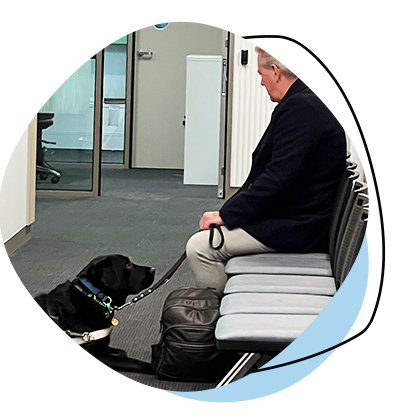ServiCe design
Enabling accessible transport on Sydney Metro
11 existing stations upgraded as part of the Sydney Metro City & Southwest project faced accessibility challenges with gaps between the platform and train.

Meld Studios partnered with Sydney Metro and Hyundai Movex to prioritise, understand and address barriers for customers who are disproportionately impacted by these gaps when boarding and alighting. This work aimed to ensure the future Platform Screen Doors (PSDs) and Mechanical Gap Fillers (MGFs) at platforms are accessible and safe for all passengers, encouraging the use of Sydney Metro.
This is the first time MGFs will be used in Australia and they will be installed from Sydenham to Bankstown (keep an eye out at the new Sydney Metro platform at Sydenham Station in August!)
Watch what we did here:
The challenge
'Assistance-free boarding' is a key feature of Sydney Metro stations with PSD and MGFs being critical technology enablers for delivering this.
Boarding and alighting are critical moments in the door-to-door customer journey. If barriers exist, they will disproportionately impact customers who have disabilities, restricted mobility, or are more vulnerable. For example, people who use wheelchairs, travel with kids, or are culturally and linguistically diverse.
We used the context of boarding and alighting with mockup PSD and MGF to explore customer accessibility, safety, and ease more broadly, identifying physical and operational barriers that may impact the customer as they travel on Sydney Metro between Sydenham and Bankstown.

The set-up
We used a life-sized mock platform and carriage with a functional PSD and MGF installed in an active train yard. The site required extensive uplift to ensure we could safely accommodate customers and observers. Over a week, the site was transformed into a safe, accessible research environment with the inclusion of;
- 32x10m weatherproof marquee
- 340sqm of temporary flooring
- A wheelchair lift
- Accessible toilets
- An accessible shuttle bus.
Images below show the before and after of the testing site -from a gravel, open train yard to a safe, accessible, and weatherproof research facility:


Who we spoke to
A rigorous research participant recruitment matrix using Sydney Metro's five personas prioritised people disproportionately impacted by boarding and alighting barriers. Several parents with young children, students, support workers and elderly customers participated, with 50% of participants identifying as having a disability, including:
- Restricted mobility
- Blind/low vision
- Deaf/hard of hearing
- Cognitive disability
- Neurodiverse/sensory impairments
- Chronic medical conditions
Researchers planned participants' research experience ensuring it would be ethical and safe by setting expectations of what would happen on the day, organising travel arrangements, and adapting to individuals’ accessibility needs. We engaged with Transport for NSW's Accessible Transport Advisory Committee (ATAC) to provide feedback on site uplift plans, communication and engagement.
The evaluative research simulated a real-life boarding and alighting experience, which let customers provide genuine feedback and reactions through:
- Using a life-sized, functional prototype (with high and low-fidelity aspects)
- Using audio and visual cues such as metro departure sounds, announcements and alarms
- Using lighting and materials
- Using a range of scenarios (normal to degraded operations) and giving customers ‘just enough’ information to feel confident in the research but allowing them to react authentically to each scenario.
- Asking customers to take on a ‘mindset’ (e.g. I'm in a rush) and use props they may travel with (e.g. bike, suitcase, pram, mobility device, umbrella).

The research
Thirty-two customers—half of whom identified as having a disability or restricted mobility—participated over two days, simulating the experience of boarding and alighting in multiple different scenarios.
Boarding and alighting are critical moments in the door-to-door customer journey. If barriers exist, it will disproportionately impact customers who have disabilities, restricted mobility, or are more vulnerable. Simply evaluating the technology wouldn’t give the full picture as many other contextual elements signal an accessible, safe, and easy experience to customers. The evaluative research simulated a real-life boarding and alighting experience, which let customers provide genuine feedback and reactions. We did this by:
- Using a life-sized, functional prototype (with high and low-fidelity aspects)
- Using audio and visual cues such as metro departure sounds, announcements and alarms
- Using lighting and materials
- Using a range of scenarios (normal to degraded operations) and giving customers ‘just enough’ information to feel confident in the research but allowing them to react authentically to each scenario.
- Asking customers to take on a ‘mindset’ (e.g. I'm in a rush) and use props they may travel with (e.g. bike, suitcase, pram, mobility device, umbrella).
The outcome and impact
The research was a low-risk, high-visibility, high-reward approach to running controlled experiments, providing insights into the customer experience beyond the ability of paper-based or conceptual research.
Outcomes of the research included qualitative and quantitative insights about customer behaviours and perceptions of the boarding and alighting experience, including 21 opportunities for improvement of the physical design and operational processes.
Meld Studios facilitated multi-disciplinary workshops with Sydney Metro, Transport for NSW and Hyundai Movex to assess and implement the 21 research recommendations by advocating for customer needs in decision-making processes, which are traditionally feasibility and viability-focused.

By embedding customer-centred design approaches into the development of public transport services and the built environment we can successfully meet customers' needs and mitigate risks by identifying issues early in the process.
As Frank Lloyd Wright said:
“You can use an eraser on the drafting table or a sledgehammer on the construction site.”
Get in touch if you’d like to discuss opportunities to bring a strong customer lens to your work, use customers to bring light to unidentified needs and considerations, and de-risk the implementation of your designs
Related case studies

Inclusive design
Designing an accessible government building
How we helped a customer-facing government agency make sure that people who are vulnerable to exclusion were genuinely included in the design of their new building.

